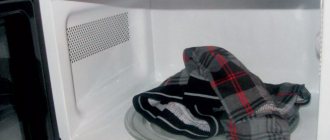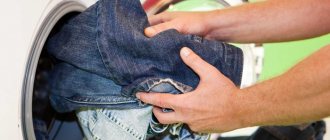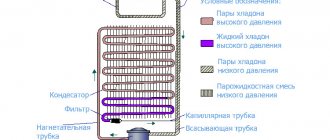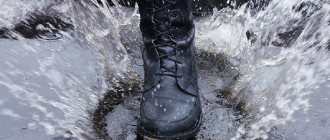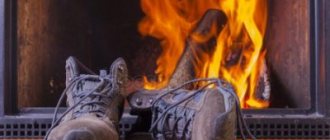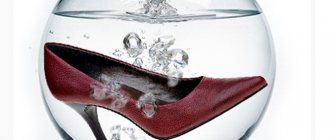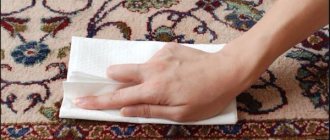Microwave
Using a microwave, you can quickly get rid of excess moisture.
It is necessary not to leave a single step from the device and release the resulting steam.
- Fold the denim item so that the metal parts are inside, otherwise a fire will occur.
- Place the pants in the microwave and turn on for 30 seconds.
- Turn over and dry again for the same amount of time.
- Repeat the procedure until the clothes are dry.
Preparatory measures
Denim fabric is quite thick and dries very slowly. If the pants are washed by hand, the water initially drips off them abundantly and then evaporates from the fibers. The longest wait is for the seams, fastener area, waistband and pockets to dry. To solve the question of how to quickly dry jeans after washing, you first need to remove excess moisture. The easiest way to do this is in the washing machine on the “gentle spin” program.
We recommend
You should not turn on the drum at high speeds: excessive pressure and twisting will deform the jeans and damage the finish.
If the product label prohibits automatic washing and spinning, terry sheets or towels will correct the situation in literally 20 minutes:
- dry cloth should be laid out on a horizontal surface;
- place wet jeans on top;
- cover with a second layer of towels;
- form a bundle or fold all layers into an envelope;
- wait until excess water is absorbed into the auxiliary tissue;
- repeat manipulations 1-5 using other towels.
In the summer, you can hang your jeans on the balcony, carefully securing them with clothespins to the edges of the legs or waistband. It is worth considering that in the sun the fabric becomes less bright, so you need to turn the pants inside out. Even in warm weather, you won't be able to dry your jeans in 5 minutes, but there are several ways to make it faster.
Is it harmful to speed up the drying process using express methods?
Drying denim too quickly will not benefit the product. When exposed to dry hot air or elevated temperatures, jeans shrink, which means there is a high risk that after quick drying, the trousers will become smaller in size. In addition, express drying methods increase the risk of deformation, in which case the product becomes shapeless and loses its original appearance.
You should resort to accelerating the drying of jeans only as a last resort, choosing the most gentle and short-term methods. Among the relatively safe ways to dry denim trousers, it is worth noting ironing with a hot iron and blowing with a hairdryer.
In a situation where you urgently need to dry your jeans after washing or after unexpectedly getting wet, you can use popular tips to speed up the drying of your clothes. Under normal conditions, you should not resort to express drying methods in order to extend the life of the product and preserve its appearance.
Rate this post
How to dry clothes quickly
There are a number of means you can use to dry your underwear other than hanging them in the air, such as:
- hair dryer;
- fan heater;
- heating battery;
- microwave.
Just don’t “twist” wet underwear in a towel - you risk tearing the thin fabric and lace. If we are talking about a bra, then such drying will lead to loss of shape and deformation of the underwires.
What to use with caution
- Iron. Quite dangerous for wet synthetics. Things should only be ironed through dry gauze or from the inside out.
- Oven. Suitable for trousers made from natural fibers, but only if it has a convection function. The door is left open, and the temperature is set to the minimum - no more than 50 degrees. There is a risk of the item getting dirty.
- Microwave. It won't help you at all here - it's only suitable for small items.
And remember - under no circumstances use open fire in the house, because synthetics are very flammable. In nature, drying things over a fire is acceptable, but only under close supervision.
Perhaps everyone at least once in their life has wondered how to quickly dry jeans. Every person has favorite things in their wardrobe that they want to wear more often than others. These clothes are comfortable and practical, appropriate in different situations. What should you do if your irreplaceable jeans have been washed and you need to put them on in a few hours? You can save the situation with the help of household appliances and improvised means.
Heating or “Vetroduy”
There is no balcony in winter, but there is central heating, which is very effective for drying jeans. It is enough to lay the raw denim on a hot radiator and do not touch it for 2 hours. Afterwards, the pants are removed, shaken and, turning over, returned to the radiator. After 2-3 hours the item is completely dry. The advantage is that the clothes warm up gradually and the fibers are not damaged. The main thing is not to forget about drying the product, otherwise the canvas will dry out and become hard and unpleasant to the touch.
In summer, you can resort to using another radiator - an electric heater. The procedure for using it will be identical with one difference - leaving an electrical appliance covered with an item without control is prohibited! You need to constantly be nearby, turn the jeans over and adjust the degree of heating. Remember that this method is a fire hazard!
Electric heaters that are running and covered with clothing should not be left unattended - this is a fire hazard!
It is much safer and more reliable to use a so-called wind blower at home. We proceed like this:
- hang denim on a chair or on a floor dryer;
- measure 30 cm;
- install a wind blower - a fan that supplies hot air;
- turn on the last one.
The wind blower ensures constant circulation of warm air, which accelerates the process of water evaporation. If you adjust the heating temperature of the electrical appliance and turn the jeans over, drying will only take a few hours. A room air conditioner is used in a similar way, the flow of which is directed onto a wet product.
comparison table
| Drying method | Drying time | pros | Minuses |
| Natural drying | 12 o'Clock in the noon | The fabric does not deteriorate | For a long time |
| Spin in a centrifuge | 5 – 6 hours | Minimum moisture remains in the fabric | Used for preliminary preparation only |
| Fan | 4 – 5 hours | Safely; low fabric shrinkage | Ineffective |
| Radiator | 3 – 4 hours | No extra effort required. Dangerous. | There is a risk of drying out |
| Electric dryer | 3 – 4 hours | Autonomy | Matter may dry out |
| Washing machine in dry mode | 1 – 2 hours | Fast, safe, autonomous | High electricity consumption |
| Hairdryer | 1,5 hour | The quality of the fabric does not deteriorate | Long and labor-intensive; Possible breakdown of the electrical appliance |
| Iron | 1 hour | Available | The tissue structure is damaged |
| Oven | 30 – 40 minutes | Fast. Dangerous | Advance preparation and observation required |
Excessive heating is bad for the condition of the fabric. The use of household electrical appliances is important when you need to lightly dry clothes. To prevent jeans from tearing and to retain their shape and color longer, you need to dry them properly: hang them straightened out on a clothesline, securing them with clothespins.
© 2022 textiletrend.ru
Tips and tricks
If you follow a few simple tips, the drying time for denim pants will be reduced, and quick drying will not affect the quality of the pants:
- Only well-wrung out, already fairly dry jeans can be quickly dried using express methods; they should be damp, and not soaking wet.
- Accelerated drying for denim pants cannot be carried out on an ongoing basis - you can resort to proven methods only in emergency cases. If you constantly dry your pants with a hairdryer, iron or oven, then your jeans will not last long.
- If drying jeans is carried out using an oven or a lit gas stove, it is necessary to constantly monitor the process and monitor fire safety. It only takes a couple of seconds to be distracted for a fire to start.
If denim pants have become the most favorite item in your wardrobe, then you should wash and dry them in advance, and not at the last moment before leaving the house.
Dry your jeans after washing at home with a towel or cotton rag.
Another method for drying jeans is to use a towel or rag. It is important to follow the instructions to do everything correctly and dry the item effectively.
Instructions for instantly drying jeans with a towel
A dry towel is laid out on the surface. The product is placed on top. They begin to roll everything into a tight bundle, as happens when squeezing things out. The action must be repeated several times. The towel will gradually become wet, so change it to a dry one every time. Complete drying will not be achieved, but the situation can be significantly improved.
Oven
If you don’t have a hairdryer or iron at home, and you need to dry your jeans quickly, then the most extreme option is the oven. In the oven, the moisture will evaporate almost at lightning speed, but the risks are extremely high. Before deciding to take such a step, you should remember the possible dangers.
- Fire. Using the oven for other purposes is extremely dangerous - there is a high probability that the jeans will catch fire and endanger the property, life and health of residents.
- Tissue damage. The oven will not ensure uniform drying; on the contrary, some areas will remain wet, while others will dry out and scorch.
The drying process itself occurs as follows. Rolled jeans are placed in a closet that has been washed and heated to 120 degrees. The door remains ajar, and every 5-6 minutes the pants are taken out, inspected and turned over. You cannot throw your trousers without supervision - a fire may start within 10 minutes, be careful! It is better not to wait for complete drying, but to finish drying the item outside by hanging it nearby.
What determines the drying time of denim?
The speed of drying jeans depends on several factors, knowing which you can significantly speed up the process:
- Room temperature. At room temperature, jeans dry in 8-10 hours.
- Humidity in the room. In a dry room, the drying speed is faster than in a damp room.
- Air movement. For uniform drying, it is necessary that the room has good ventilation.
Drying jeans under these conditions is much easier and faster.
We use an iron
An iron is the most effective means of drying jeans, but you should be extremely careful.
Iron drying is the most justified and proven method. The actions will be as follows:
- Turn your pants inside out.
- Flatten them on the ironing board.
- Turn on the ironer and set the temperature to the highest setting.
- Initially, “go” at the seams. Pay due attention to pockets and belt. Then move on to other areas.
The item will be completely dry, the inconvenience during drying is minimal.
Heating radiators
If you have water or gas radiators in your apartment, and it’s autumn-winter outside, then you can use them to dry things. The method is longer, but effective. It is quite possible to dry jeans in a few hours, without any physical effort.
You need:
- Unscrew the product well.
- Place it on the battery.
- Periodically turn over to the wet side.
If you have individual heating, turn it on to maximum.
It is prohibited to use electric radiators; a short circuit may occur and you will get an electric shock.
Let's see what the pants are made of
Anything can happen in our lives - well, the jeans haven’t had time to dry after washing and that’s it... Or they got soaked to the skin in the rain, but we have to run somewhere again and there’s no way we can miss this meeting, and there’s no time to wait for the jeans to dry on their own. It is unknown how long they will dry on their own... Still, they are not sweatpants - they are at least partially made of synthetics and dry faster. And here are natural materials that love to take in water, but not to give away. How to dry jeans at home quickly?
In order not to ruin your favorite pants during the “emergency” drying process, you need to understand what material you are dealing with and how you should not deal with it. The term “jeans” can hide any type of denim fabric.
- Denim. The thickest, but also the most expensive denim option. Large percentage of cotton. Dense and hard at first, over time it becomes softer, but does not lose strength. Only the front side of the fabric is blue, and the back is almost white. This is exactly what the first Levis were like, driving Soviet fashionistas crazy.
- Stretch. The cotton base is diluted with elastane or lycra. The degree of “stretchability” of the material depends on the percentage of threads. These jeans are flexible and fit well, without restricting movement.
- Broken twill. Here the threads are woven in a herringbone pattern. This type of weaving gives the cotton fabric some elasticity without adding elastane.
- Ecru. Undyed denim. It has the natural color of cotton thread.
- Chambry. The thinnest version of denim. “Light” denim items are sewn from it: shirts, summer sundresses, swimsuits and even underwear.
- Gin. Cheap looking denim. The price is a consequence of the low quality of raw materials. This type of “jean” is soft to the touch, the weave is loose, and does not hold its shape well. It is from this that low-price items are made, but they are not particularly durable.
Fabrics with a high cotton content “shrink” from high temperatures. Therefore, washing and drying such denim items is only permissible at a temperature not exceeding 40℃. Jeans are also afraid of creases, which are then difficult (and sometimes impossible) to get rid of. Therefore, we wash at low drum speeds, and dry them straightened without kinks.
If you do it according to the rules
Before you start talking about how to dry thoroughly wet jeans in a short period of time, it’s worth understanding the rules of proper drying. There are only four of them.
- Natural process. Quick drying is always an emergency measure, damaging the fibers of the fabric and shortening the wear time of the pants. In a good way, it is better to dry jeans naturally - on a clothesline or a special dryer installed in the fresh air or in a well-ventilated area.
- Down with your feet. You need to hang denim pants in the same position in which you wear them. And not upside down, as many people think. The most convenient way to secure the waistband of your pants to a rope or wire is with clothespins.
- Inside out. Ultraviolet radiation negatively affects the quality of fabric, so rich colors often fade in the sun. To prevent this from happening, jeans must be dried inside out, exposing the reverse side to the sun's rays.
- Strong spin. Jeans are not at all afraid of the high speed of the washing machine drum. Therefore, they can be safely pressed even on the strongest mode. This process will not have any negative effect on the fabric, but it will remove moisture from clean pants to the maximum.
Is it possible to dry jeans in a dryer?
Special devices for drying clothes allow you to remove residual moisture from fabric very quickly, in about half an hour. However, machine drying is not suitable for all things, and the question arises whether denim pants can be loaded into such a machine.
Drying fabric in an automatic machine occurs as follows - things rotate in a drum under the uniform influence of heated air. There is no need to perform any additional actions when machine drying; just set the appropriate mode and wait for the end of the cycle. However, the hot air in the dryer can harm some fabrics.
For example, you cannot quickly dry in an automatic dryer:
- nylon and other elastic fabrics;
- cambric and tulle;
- chiffon;
- garments with appliqués or colored prints;
- clothes with decorative metal or plastic elements;
- items with leather inserts, embroidery and appliqués;
- things with rhinestones and beads.
You can dry jeans in an automatic machine, but only if they do not have printed pictures, voluminous decorations, appliqués or other artistic elements. You should only put classic denim pants made of thick material into the dryer, otherwise the item can be irrevocably damaged.
You should once again study the labels on the clothes; usually the manufacturer specifically indicates whether the trousers are suitable for automatic drying, and in what mode they can be quickly dried. Before you put your jeans in the dryer, you must fasten all the zippers and buttons on your pants.
“Stretch” stretch jeans are not suitable for machine drying; intense exposure to hot air will lead to deformation of the garment.
Hair dryer
A hairdryer is also good for drying jeans at home. Its advantage is that you can direct the air flow to any place and make heating as uniform as possible. But the drying speed depends entirely on the power of the device.
It is not recommended to keep the hair dryer turned on for a long time - the device overheats and breaks.
Dry trousers as follows:
- turn the jeans inside out and straighten them along the length;
- fix it on hangers and hang it in the bathroom;
- turn on the hairdryer to medium temperature and start drying: gradually move the device from top to bottom, covering the entire area of the product;
- after 7-10 minutes, turn off the hair dryer and let it “rest” (prolonged use leads to overheating of the device);
- during a break, shake the denim and turn it inside out;
- we take on the trouser legs, lowering the device inside each trouser leg;
- We monitor the air filter of the hair dryer, which should always be located outside;
- As soon as the main part of the fabric has dried, we begin to work on difficult areas - belts, pockets, stripes.
Blow-drying is effective, but difficult: your hands are under constant tension and get tired quickly. The disadvantage will be that the device consumes a large amount of electricity. Another “minus” is the risk of the device overheating and failure.
